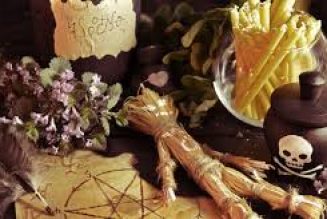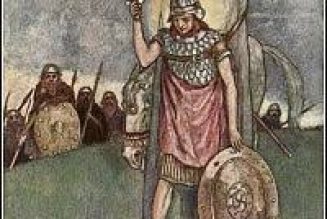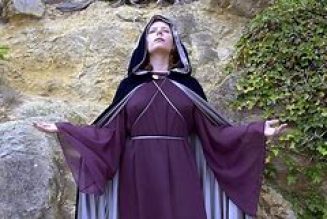In folklore, low-ranking demons in constant attention to witches for the purpose of carrying out spells and bewitchments.
Familiars usually assumed animal forms—cats, toads, owls, mice, and dogs were the most common—though virtually any animal or insect could be suspected.
In witchcraft trials, if so much as a fly buzzed in the window while a witch was being questioned or tried, it was said to be her familiar.
The inquisitors took the Bible to heart.
Those who had familiars were “an abomination unto the Lord” and should be “put to death.
They shall stone them with stones, and their blood shall be upon them.”
Familiars—also called imps—were said to be given to witches by the Devil or bought or inherited from other witches.
A witch could have several of them.
Cats were the favored forms, especially black ones.
The fear that all cats were witches’ familiars was one of the reasons for cat massacres that swept through medieval Europe.
Familiars were given names like any household pets, which most of them undoubtedly were.
One 16th-century Essex woman accused of witchcraft admitted that she had three familiars in the form of mice.
Littleman, Prettyman and Dainty were their names.
Another had four mice named Prickeare, James, Robyn and Sparrow.
Elizabeth Clark, the first victim of Matthew Hopkins, England’s great witch-hunter of the 17th century, confessed to having five familiars, including unearthly ones.
These included Holt, a kitten.
Jamara, a fat, legless spaniel.
Sack and Sugar, a black rabbit.
Newes, a polecat,
And Vinegar Tom, a long-legged, greyhound-like creature with an ox’s head and broad eyes, which could turn itself into a headless four-year-old child.
Other familiars named in trials included Grizel, Greedigut, Peck in the Crown, and Elemauzer.
Perhaps the best-known familiar name is Pyewackett, the moniker of the witch’s cat in the movie Bell, Book and Candle, and a name that dates to Renaissance England.
Pyewackett, Hopkins stated, was a name “no mortal could invent.”
Witches were said to take great care of their familiars.
As Emile Grillot de Givry described in Witchcraft, Magic, and Alchemy
“they baptized their toads, dressed them in black velvet, put little bells on their paws, and made them dance.”
Familiars were dispatched to bewitch people and animals into sickness and death.
They also protected their witches.
In return, witches gave them what they craved: blood.
Alice Kyteler of Kilkenny, Ireland, convicted as a witch in 1324,
Three witches and their familiars (Woodcut from the Wonderful Discoverie of the Witchcrafts of Margaret and Philip was made to confess) that she sacrificed red cocks to her familiar.
It was believed that witches allowed familiars to suck blood from their fingers or any protuberance or unnatural spot on the skin.
The existence of witch’s marks was proof of suckling familiars and therefore of being a witch—enough evidence to get witches hanged.
Familiars also were said to assume more than one shape.
Agnes Waterhouse, an Englishwoman accused of witchcraft in 1566, had a cat familiar named Satan that could change into a dog .
Familiars also could vanish at will.
It should be noted that the appearance of the Devil himself as an animal was not the same as the appearance of a familiar.
If a witch was arrested, she was often tied up and left in a cell, while inquisitors watched secretly to see if her familiars came to her aid.
Even an ant or cockroach crawling toward her was called a familiar.
Religion was a charm against the familiar’s infernal power.
Waterhouse was said to be unable to harm one man through her familiar cat because of his religious beliefs.
During the witch hysteria, the obsession with familiars was most prevalent in England and Scotland, where they are mentioned in numerous trial records, especially those related to Hopkins.
The Witchcraft Act of 1604 made it a felony to “consult, covenant with, entertain, employ, feed, or reward any evil and wicked spirit to or for any intent or purpose.”
But the Malleus Maleficarum (1486), the major witch inquisitor’s handbook, offers no instructions concerning familiars in the interrogation and trial of witches.
The book does acknowledge that an animal familiar “always works with her [witch] in everything.”
It also advises inquisitors never to leave witch prisoners unattended, because the Devil “will cause her to kill herself.”
The Devil might accomplish that through a familiar.
There is scant evidence of familiars in early American witch trials.
In the Salem trials in 1692, John Bradstreet was indicted for “inciting a dog to afflict.”
The dog was tried and hanged as a witch.
Outside of witch trials, more benevolent familiars were believed to exist, serving wizards and wise men and women who were magicians or village healers.
The familiars helped diagnose illnesses and the sources of bewitchment and were used for divining and finding lost objects and treasures.
Magicians conjured them with rituals, then locked them in bottles, rings, and stones.
They sometimes sold them as charms, claiming the spirits would ensure success in gambling, love, business or whatever the customer wanted.
This sort of familiar technically was not illegal; England’s Witchcraft Act of 1604 specifically prohibited only evil and wicked spirits.
Some familiars were said to be fairies. Oberon was a popular name for fairy familiars in 15th- and 16th-century England.








